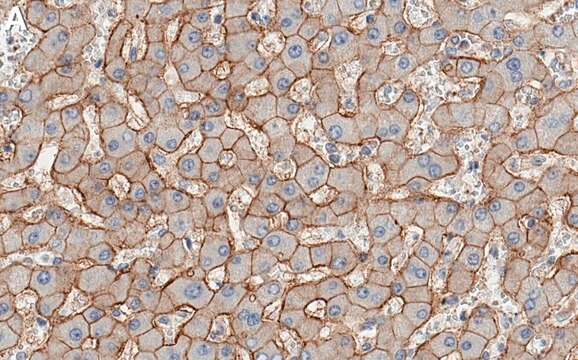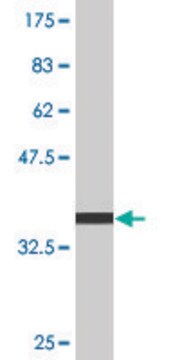MABN1785
Anti-CD166 (ALCAM) Antibody, clone TAG-1A3
clone TAG-1A3, from mouse
Synonyme(s) :
Activated leukocyte cell adhesion molecule, CD166 antigen
About This Item
Produits recommandés
Source biologique
mouse
Niveau de qualité
Forme d'anticorps
purified immunoglobulin
Type de produit anticorps
primary antibodies
Clone
TAG-1A3, monoclonal
Espèces réactives
human
Conditionnement
antibody small pack of 25 μL
Technique(s)
flow cytometry: suitable
immunocytochemistry: suitable
immunofluorescence: suitable
immunoprecipitation (IP): suitable
western blot: suitable
Isotype
IgG1κ
Numéro d'accès NCBI
Numéro d'accès UniProt
Conditions d'expédition
ambient
Modification post-traductionnelle de la cible
unmodified
Informations sur le gène
human ... ALCAM(214)
Description générale
Spécificité
Immunogène
Application
Immunocytochemistry Analysis: A representative lot detected CD166 (ALCAM) in Immunocytochmistry applications (Ding, Y., et. al. (2014). MAbs. 6(6):1439-52).
Immunoprecipitation Analysis: A representative lot detected CD166 (ALCAM) in Immunoprecipitation applications (Ding, Y., et. al. (2014). MAbs. 6(6):1439-52).
Flow Cytometry Analysis: A represetative lot detected CD166 (ALCAM) in human embryonic stem cells, human corneal stromal fibroblast (hCSF) cells, immortalized human corneal endothelial cells (B4G12), and human endothelial cells from donors (2) (Courtesy of Dr. Vanessa Ding, Ph.D. and Dr. Andre Choo, Ph.D, BTI, Singapore).
Immunofluorescence Analysis: A representative lot detected CD166 (ALCAM) in Immunofluorescence applications (Ding, Y., et. al. (2014). MAbs. 6(6):1439-52).
Western Blotting Analysis: A representative lot detected CD166 (ALCAM) in Western Blotting applications (Ding, Y., et. al. (2014). MAbs. 6(6):1439-52).
Neuroscience
Qualité
Isotyping Analysis: The identity of this monoclonal antibody is confirmed by isotyping test to be human IgG1 .
Description de la cible
Forme physique
Stockage et stabilité
Autres remarques
Clause de non-responsabilité
Vous ne trouvez pas le bon produit ?
Essayez notre Outil de sélection de produits.
Code de la classe de stockage
12 - Non Combustible Liquids
Classe de danger pour l'eau (WGK)
WGK 1
Certificats d'analyse (COA)
Recherchez un Certificats d'analyse (COA) en saisissant le numéro de lot du produit. Les numéros de lot figurent sur l'étiquette du produit après les mots "Lot" ou "Batch".
Déjà en possession de ce produit ?
Retrouvez la documentation relative aux produits que vous avez récemment achetés dans la Bibliothèque de documents.
Notre équipe de scientifiques dispose d'une expérience dans tous les secteurs de la recherche, notamment en sciences de la vie, science des matériaux, synthèse chimique, chromatographie, analyse et dans de nombreux autres domaines..
Contacter notre Service technique








